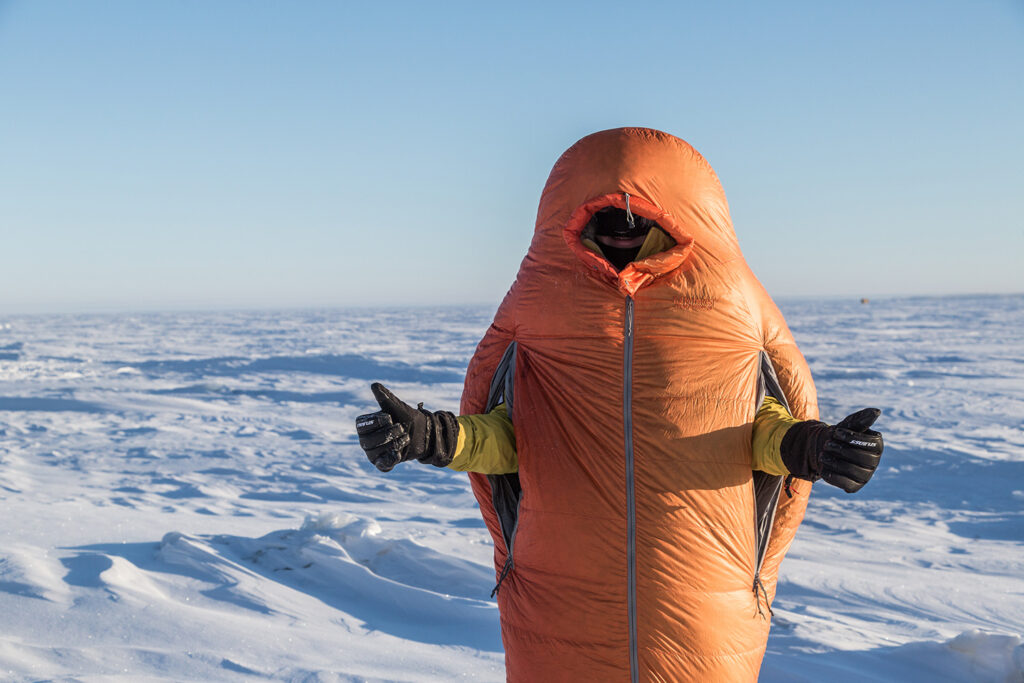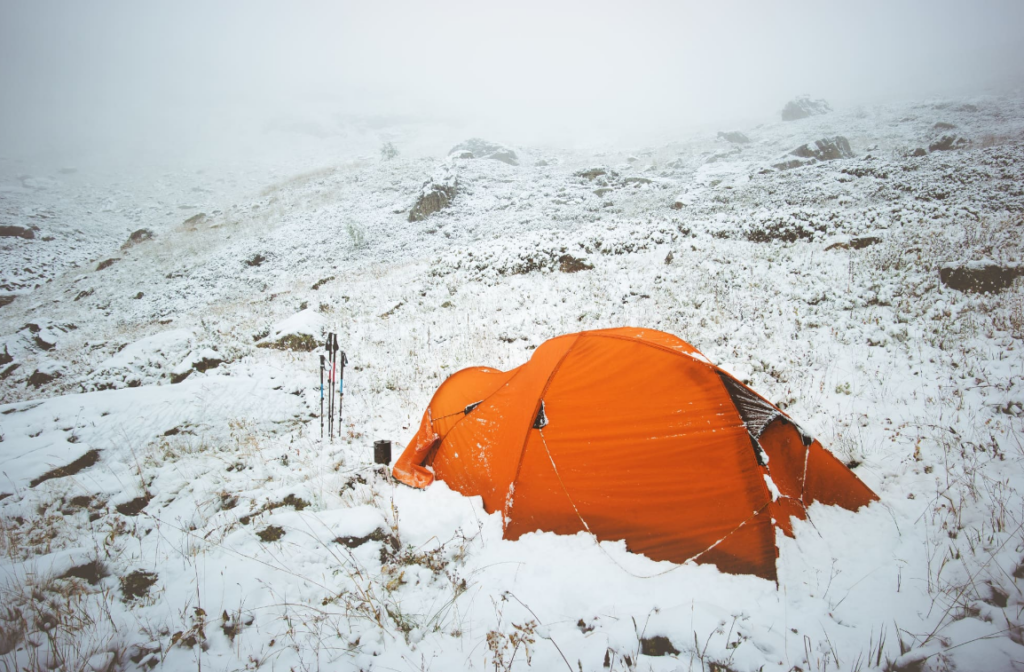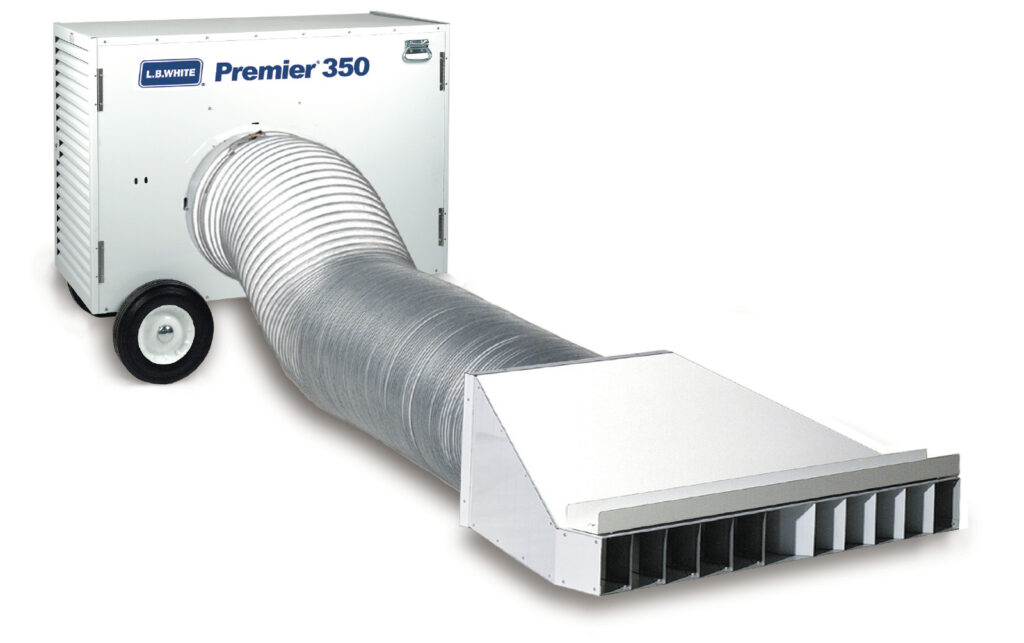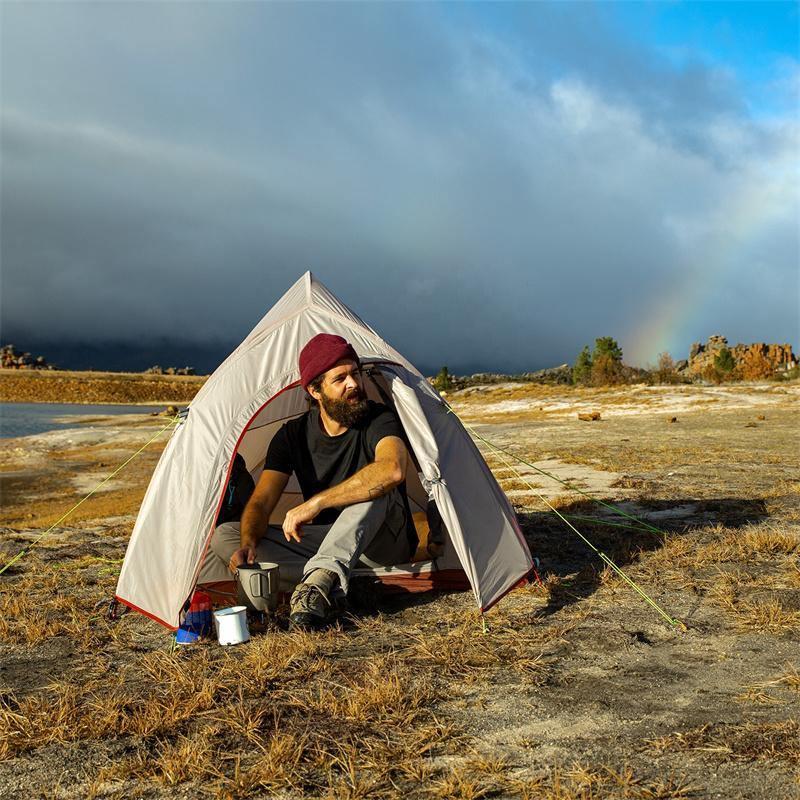You can insulate your tent for winter camping with rigid foam, tarps, or blankets. The most effective way is to glue the fabric to the inside of the tent. This reflects some of the heat back to you. However, this is an incredibly tedious process. So if you want to set up your tent quickly, you should try the outdoor variant. You can learn more about these materials in the following sections.
Table of Contents
Insulation
Most heat is lost to the ground, especially at night. That’s why good insulation against the ground is the be-all and end-all of a warm night. Even if you’re out and about without a tent, the insulation from the groundworks wonders.
Air beds and air mattresses (yes, the pool things) offer very little insulation, no matter how comfortable they are. If you want to sleep on an air bed, be sure to put a sensible sleeping mat underneath!
Camp beds lift the body off the ground but don’t prevent the air beneath them from cooling with it. Here, too, additional insulation must be created, optionally with an insulating blanket or mat on the camp bed.
The right insulation
Insulation blankets are single-sided blankets suitable for sitting on the floor at picnics. Unfortunately, these are mostly designed so that the person using them is still moving. They are therefore usually not suitable for sleeping.
“Real” foam pads are better at this point. These don’t cost the earth, they are always on sale somewhere for less than 10 dollars.
Advantage: Thicker foam mattresses also “insulate” against uneven floors and small stones. Disadvantage: Such a rolled-up sleeping pad takes up space in the car. But you can compensate for that by using them in the car as foam protection for fragile things like lanterns etc.
The luxury version is inflatable or even self-inflating sleeping mats. But please make sure that you are actually buying a sleeping mat here and not just a beautifully labeled air mattress! Also, sleeping pads that work with air should be filled to the brim (contrary to the instructions for airbeds!) so that you don’t squeeze them together at night and then end up lying on the ground again.

Support the sleeping pad
If the sleeping pad is too thin, you can reinforce it with blankets or spare clothing by placing them under the sleeping pad. Such a reinforcement makes sense, especially in the pelvic area.
Stay on the mat
Make sure you don’t wake up in the middle of the night with any part of your body leaving the sleeping pad – if so, take appropriate precautions to prevent this in the future. For example, you can use a larger sleeping pad, place several sleeping pads next to each other (but make sure that they do not spread apart), or, if these are only fleeting touches, place a camping thermal blanket under the sleeping pad.
If nothing helps, because you tend to rotate at night, try sleeping on your stomach or going into the “stable side position” before falling asleep – this very effectively prevents such rotations, even if they are not the most comfortable sleeping position.
The quieter you sleep, the warmer it gets. This is also due to the fact that you exchange less air in the sleeping bag, i.e. less cold air is drawn into the sleeping bag.

The sleeping bag – A story full of misunderstandings
Let’s come to the second big sticking point: the sleeping bag. Unfortunately, this is where most mistakes are made.
Find the right sleeping bag
The more extreme the temperatures, the better the sleeping bag has to be. At this point, I strongly advise against sleeping bags from the discounter – sleeping bags should definitely be purchased in a specialist trekking shop, especially since the seller there can give you further tips.
Every good sleeping bag has a specified temperature range in which it works best. This area is usually called the “comfort zone”. For our latitude, it is important that the comfort zone also extends a little into the minus degrees, because that can definitely happen. But of course you don’t need a polar sleeping bag.
It is also important that the sleeping bag fits you. A sleeping bag that is too small is uncomfortable and cramped (and is therefore often left open), a sleeping bag that is too large does not really get warm.
If you tend to freeze, make sure you get a mummy sleeping bag with a hood, which can also prevent chilling over your head.

How a sleeping bag works
A sensible sleeping bag is designed to reflect body heat back.
This works all the better the more the skin comes into contact with the sleeping bag. So there is a paradox here: the colder it is, the less clothing you should wear in your sleeping bag. So you should only wear something if you get too warm.
Anyone who climbs into the sleeping bag with three jogging pants, two T-shirts and a sweater will not be able to heat up the sleeping bag.
Blankets on the sleeping bag!
If it’s so cold that the sleeping bag is at the edge of its capacity, or you just don’t trust the sleeping bag, you can put as many layers of blankets on the sleeping bag or wrap it around the sleeping bag as you like. But please don’t put those blankets in the sleeping bag.
Watch your head
Humans lose a lot of heat through their heads. So if you get cold at night, try to cover your head, preferably with the hood of your mummy sleeping bag. You can usually pull the hood up, except for a small breathing hole.
If you don’t have a hood, you can try a good hood, provided it’s thick and warm enough.
Bonnets, headscarves, etc. are usually not enough to keep your head warm while you sleep.
Store the sleeping bag
Most sleeping bags work with down feathers. The better these puff up, the warmer the sleeping bag keeps you. Over time, sleeping bags lose their “loft” and thus their thermal performance, so they should be replaced at some point.
In order to maintain the bulkiness for a long time, you should never roll the sleeping bag – even if it was delivered rolled. Better stuff it in the stuff sack or, if possible, give it even more space.
Never stow away the sleeping bag immediately after getting up, but let it air out beforehand, preferably completely open.

Extra tip: hot stones
If your body heat is not enough to heat up the sleeping bag, or you have notoriously cold feet, the following trick will help: put a stone near the fire so that it heats up. You then take the warm stone into the tent and put it in the bottom of your sleeping bag.
But make sure that it doesn’t get too hot – you should still be able to touch the stone. If the stone gets too hot, the heat can damage the sleeping bag!
Extra tip: Inlay when it’s warm
If it is much too warm in your sleeping bag in summer, you can of course reduce the reflection of body heat with clothing. A washable cotton inlay makes it more comfortable. You can either buy this ready-made or make it yourself: Get a good cotton bed sheet, fold it once and then sew it together on the long and one short side.
Actually a no-go: partner sleeping bags
At first glance, partner sleeping bags seem like an interesting idea, but unfortunately the disadvantages outweigh the disadvantages. Especially when it’s cold, they let in far too much air through the enormously wide and not properly closed head end, so that both partners are cooled rather than warmed. Unfortunately, the effect of mutual warming does not work either. Pure partner sleeping bags are therefore absolutely not recommended in cold weather.
Here it is more worth using normal sleeping bags and simply opening them up on warmer nights and converting them into a common blanket.
There are also sleeping bags that work individually or can be put together as a partner sleeping bag. Here it is necessary to pay attention to the comfort zone, especially those in combined mode. These sleeping bags should definitely be taken apart and used individually on cold nights.
On normal nights you still have the combined partner sleeping bag – or, depending on the system, a triple or quadruple sleeping bag if required … sense and use are up to you.

Keeping the tent warm in winter
Here we would like to give you a few tips on how to keep the tent slightly warm in winter or when the outside temperature is cold.
Seal the entrance
Even the best sleeping bag doesn’t help if it gets clammy or even damp during the night. The same applies to blankets, clothing, etc. It is therefore extremely important to always close the tent properly, especially at night. This may fail with some entrances due to general laziness – here you just have to give yourself a push.
Another advantage of a closed tent: it heats up better over time due to the air you breathe.
Tent communities
The colder it gets, the more people should stay in the same tent to heat up the tent better. Here it is important to balance privacy and warmth, I leave that to you.
Extra tip: the candle
You can “preheat” the tent by simply putting a candle in the tent half an hour before going to bed – of course only in a suitable and safe lantern, so that it cannot fall over and set the tent on fire. This also draws residual moisture out of the tent and outside through the hopefully existing roof ventilation.

A little fire burns
Some tents, especially yurts, allow a fire to be kept inside the tent. But you should only do this if you know what you are doing.
If you sleep in a tent with fire, sleep with your feet toward the fire. In other words, sleep with your head as far away from the fire as possible. As a result, you breathe in less smoke and, above all, fewer gases that are produced during combustion.
Tent heaters
Tent heaters replace the candle or the fire in the tent with a burner, usually gas-powered. The problem with tent heaters, however, is that the tent must be designed for them – most tents are not.
Firstly, a burner in the tent produces exhaust fumes and these must be able to escape. Fire-rated tents, such as yurts, have a smoke hole, and simple tents can handle the fumes from candles or miners’ lamps through the roof openings. However, the roof openings of most tents are undersized for the exhaust gases of a gas burner, which can lead to exhaust gas accumulation in the tent.
Second, the torch draws oxygen. That means it competes with you for breathable air inside the tent and usually requires that you leave one of the lower tent vents open. There are heaters that can get their combustion air from the outside with a hose, but this problem does not exist here.
Third: Heating versus groundsheet. Be sure to pay attention to how warm the underside of the heater gets during operation. When the burner is mounted on its gas bottle, it usually stays quite cold as the decompression of the gas cools the bottle. However, if the gas is supplied through a hose, it is possible that the heater itself will become warm on the contact surface and damage the tarpaulin as a result.
Fourth: External heating? Most tent heaters are designed to stand inside the tent they are heating. But there are also systems that are outside the tent and transport warm air into the tent. These don’t have some of the problems described above, but they do have two new ones: They mostly make a fan noise, and they’re not exactly quiet.

Two dangers must be mentioned here.
On the one hand: If the gas system of the tent heater is not tight, or the burner is defective and goes out, the heater pumps the unburned gas into the tent. This happens very rarely, but it does happen, so be sure to handle the device with care. On the other hand, the burner should be secured against falling over, because it is quite hot enough to set the tent on fire.
In summary, I would advise against tent heaters and go for more traditional methods. If you want to use a tent heater, be sure to seek advice and make sure that your tent can be safely heated with this type of heater. In any case, please read the operating instructions for the heater carefully and observe them.
Final tip on how to stay warm in the tent in cold temperatures
An empty stomach likes to freeze
Make sure you don’t go to bed hungry. If the body has to heat up at night, it needs energy to do so.
A hot meal before bed is most effective. If, for whatever reason, you don’t want to eat a full meal before bed, try eating at least one banana or something similarly energizing.
A last warm tea before falling asleep is also not to be sneezed at.
Warm in the morning
Finally, a tip for the morning after: If you pack the clothes for the next day in the bottom of the sleeping bag, they will already be warmed up the next morning.



